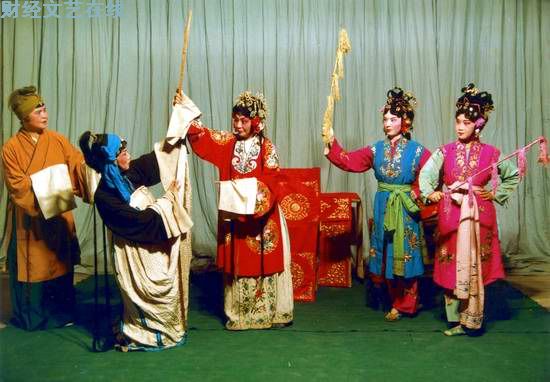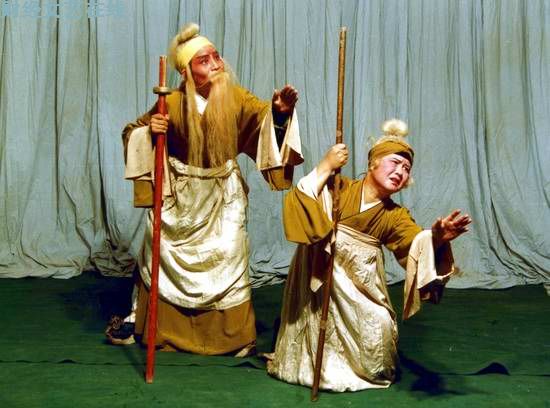The Yiyang tune -- one of the four great tunes from the Southern Opera (the other three are Yuyao, Kunshan and Haiyan tunes) -- played a significant role in the development of Chinese opera.
The Yiyang tune was formed at
the end of the Yuan Dynasty (1271-1368) and the beginning of the Ming Dynasty
(1368-1644) in Yiyang county, Jiangxi province. As early as the Yongle reign
(1403-1424) of the Ming Dynasty, the Yiyang tune was not only prevalent in
Jiangxi province, but also in Anhui, Fujian, Yunnan and Guizhou provinces.
In fact, the tune first
emerged by combining operas around the Yiyang region with its local dialects.
Reputed as the overlord of Chinese opera, together with the Kunshan tune, the
Yiyang tune exerted great influence on the 44 types of Chinese opera, including
Peking Opera, Sichuan Opera, Hunan Opera, Qinqiang Opera, etc. The Yiyang tune
is therefore regarded as the absolute forefather of Chinese high-pitched
operas.
As a highly refined opera, the
Kunshan tune was favored by scholars, bureaucrats and literati, but only
captured the attention of the Wuzhong region in the Ming Dynasty; the Yiyang
tune, on the other hand, which was almost completely neglected by scholars,
became a folk art adored by ordinary people.
 |
| Torturing Jin Zhen (photo from cjwy.net) |
II. Main
features
During a Yiyang tune
performance, an actor performs a solo on stage, with others joining in offstage
to accompanying percussion instruments. Yiyang tune artists have created "gun
diao" -- a type of spoken word, where each sentence of the same length is added
after the long or short aria. Gun diao can be subcategorized into "gun bai",
where a paragraph is recited between two arias, and "gun chang ", where a
paragraph is sung between two arias.
The Yiyang tune, which does
not have musical scores, is performed according to the local folk tune patterns.
Free from the restriction of musical scores and embracing local dialects, Yiyang
has a competitive edge over the refined Kunshan tune.
Since the Yiyang tune features
one singer with others joining in, it can be performed in squares and on
grasslands, and caters to the tastes of ordinary people. Therefore, the tune
could be enjoyed by people in different places and because of this, spread
quickly across the nation.
III. Influence on
other tunes
After the mid-Ming Dynasty,
the Yiyang tune was introduced to Beijing, Nanjing city, Jiangsu province,
Anhui, Zhejiang, Hunan, Guizhou and Yunnan provinces and Guangxi Zhuang
Autonomous Region. Combined with local dialects and folk songs, it quickly gave
birth to many new local operas, such as the Jiangxi province Leping tune, the
Anhui province Huizhou tune, the Qingyang tune (also called "Chizhou tune"), and
the Beijing Jing tune.
At the end of the Ming
Dynasty, the Qingyang tune improved the gun diao performance style created by
the Yiyang tune, where spoken words of equal length are added after the long or
short aria, thus boosting the development of the high-pitched opera system. The
high-pitched operas then spread to Hubei, Sichuan, Henan, Shanxi andShandong
provinces, and were collectively called "qing xi" ("pure opera").
At present, high-pitched
operas mainly include Sichuan Opera, Hunan Opera, Chenhe Opera and Ganju Opera,
which have inherited such characteristics of the Yiyang tune as beating time
with a drum, featuring one singer with others joining in, and adding spoken
words between two arias. Some operas also use wind and stringed instruments.
 |
| Coming across the Son in the Pavilion (photo from cjwy.net) |
IV. Current
situation
Compared to the Kunshan tune,
which has been placed under systematic protection, the survival of the Yiyang
tune is currently being threatened. Due to the passage of time and changes in
people's aesthetic tastes, the Yiyang tune has gradually declined.
First of all, fewer and fewer
people are paying attention to the Yiyang tune, and its remaining artists, who
have graduated in the 1950s, are all around 60 years of age. Currently, only
five to six old artists can still master the opera.
Due to funding shortages, the
collection and arrangement of related materials have been put on the back shelf.
And no troupes or venues currently exist to stage public performances. Some
experts warn that this ancient art form is on the verge of extinction; they say
it will die out in 20 years unless new blood is trained.
No comments:
Post a Comment